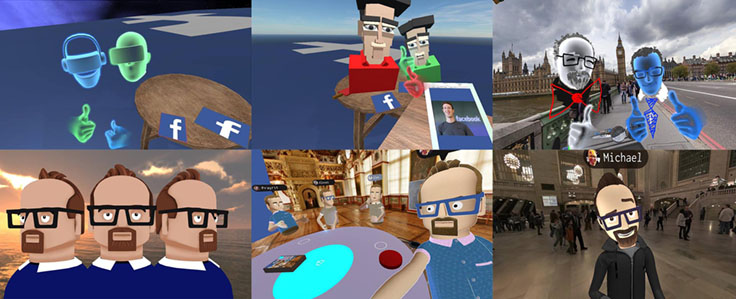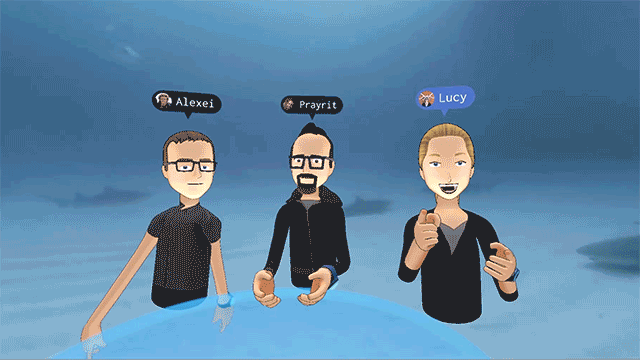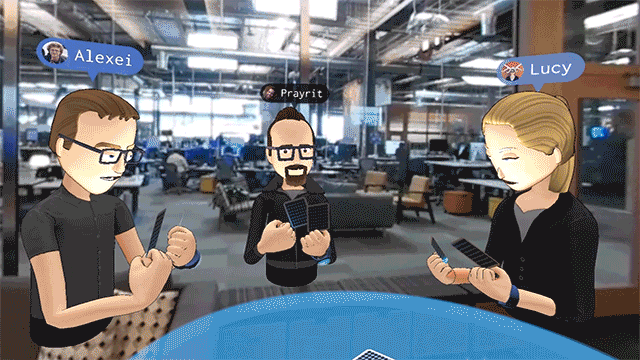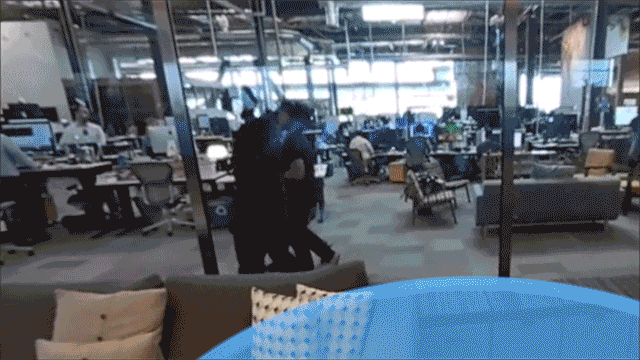Today, modern computing platforms are primarily organized around the applications used to accomplish a task. Just think of the grid of apps on your phone, each for a specific purpose. But we believe VR will be different. It will be a computing platform that puts people first. It will also be the most natural social platform ever built, with you at the center, choosing what you want to do and who you want to do it with. Because whether it’s playing a game, watching a movie, or exploring a different world — it’s better when you do it with friends. And because it’s not always possible to connect in person with the people you care about, VR technology will create new ways to connect and feel like you’re together even when you’re apart. For the past several months, we’ve been exploring what that future platform will look like.
At our F8 conference this year, we showed a first glimpse of our early work in social VR. On stage today at the Oculus Connect conference, we gave a demo showing our newest explorations, including:
- More expressive, representative avatars that can better portray your true self in VR
- The ability to go anywhere and relive meaningful memories in new ways: Experience both 2D and 360 photos and videos together, or share photos, videos, and posts from Facebook with your friends in VR
- Early demonstrations of how objects can help you interact in fun, engaging ways like you would in the real world
- Seamless ways to communicate with people who aren’t in VR, and share memories you make in VR with your friends on Facebook
The core concepts and learnings behind these experiments will define the social VR experiences of tomorrow. Let’s dive into more detail.
See your friends in VR
If you’re hanging out with friends in VR, it’s better when they actually look like your friends. This enhances “social presence” — the feeling that you’re actually there together. So in our experiments with avatar design, we’ve optimized for avatars that look realistic without being uncanny, while allowing for believable movement that makes social interaction feel more natural. We’ve tested more than a dozen designs, ranging from more realistic to more stylized, and even some non-human forms. Along the way, we learned that a more realistic avatar helps people connect with each other in a way that’s closer to interacting with friends in person. We’ve found that it can also make you more comfortable in your virtual skin, and let you share VR memories featuring a “you” that looks like you.

From there, we started adding other components to strengthen the feeling of presence:
- Arms and body: While we can’t yet track and reproduce the precise movement of torso and limbs, we can algorithmically approximate arm and body position based on the tracked position of head and hands. We chose to represent avatar arms this way because we found that having a more realistic physical form amplifies the feeling of connection.
- Eyes: Eye contact makes a big difference — you really feel the connection when your friend is talking and looking at you while meeting your gaze. But if avatar eyes are too wide and glassy, or motionless, they can create a disturbing effect. We worked to achieve an eye design that avoids that problem, and even added blinks to enhance realism.
- Mouth movement: Lip motion creates a visual indicator that someone is talking, helping conversation flow more naturally. We enabled basic mouth movement triggered by your voice.
- Emotions: When avatars don’t display emotions, you have to rely on cruder signals (like voice or head/hand motions) to relay social cues. Our avatars can display emotions and expressions like “smiling,” “confused,” “skeptical,” or “listening.” This makes it easier for people to communicate how they’re feeling.

While these improvements all help enhance social presence, there’s still much more to be learned in avatar design. We’re continuing to prototype, iterate, and test new designs every day.
Go anywhere and do anything together
One of the most exciting things about VR is that you can go anywhere and do anything with the people you care about. We’re exploring how tools and objects can expand the range of what people can do in VR, add utility, and help people interact. In the early days of social VR, one of the things people have enjoyed doing together is playing with toys and games — so today we showed some of the play-focused objects we’ve recently been experimenting with, like a cards and a toy sword. Our team has had fun playing with these, and we’re continuing to investigate this space with other objects that help make social VR experiences more useful or engaging.

Beyond playing with toys, VR also allows you to experience whole scenes together. Today we showed the new ability to enter 360 videos with a friend, so you can go anywhere in the world or relive any moment captured in 360. In our demo, we traveled to several amazing places including Mars and the bottom of the sea.
Also for the first time, we showed the ability to share photos, videos, and posts with your friends in VR like you do on Facebook today. This unlocks a whole new world of interesting content to be shared in VR — from showing a friend your latest vacation photos to letting your distant family experience your child’s first steps in full 360. Experiencing personally meaningful content together is one of the many ways that people will use VR in the future, and we’re excited by the possibilities.
Share VR experiences with anyone
VR allows us to be with anyone, even if they’re physically far from us. And we believe VR should have ways to bring everyone in — not just those who are in VR at that moment. Today for the first time, we showed how people in VR could share their VR experience with friends who are outside VR, in real time, via Messenger video calling. With this, you could call a friend who’s in VR from your phone and instantly open a window into their virtual world. We’ve also been working on ways to capture your VR experience and share it outside VR — as a selfie, as a video, and eventually as a 360 video too. Social VR is more fun and more powerful when you can share it with anyone.

What’s next
While there’s still a ways to go, our experiments have made us even more optimistic about VR’s potential as a people-first platform. We’ll be continuing to prototype and learn what makes social VR work, as we also continue to invest in VR hardware, software, and research. We can’t wait to learn what’s possible and see it come to life.









